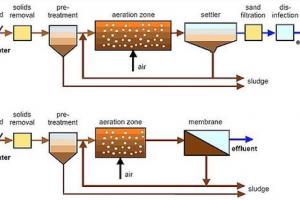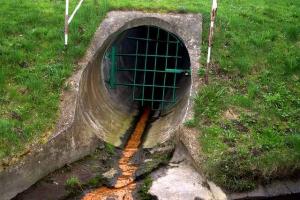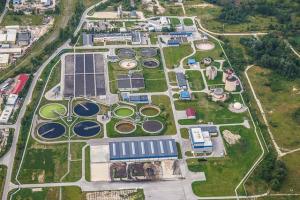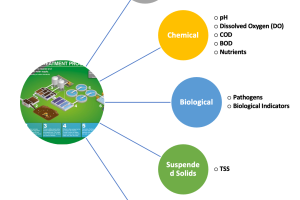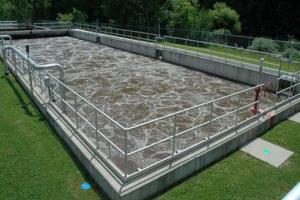Process of Environmental Impact Assessment - Stages in EIA

Screening
The first step in Process of Environmental Impact Assessment is to decide whether or not EIA is required. It is a preliminarily study to investigate the negative and positive impacts of a proposed project. The project type and size is used to evaluate the extent of potential environmental impacts. Small projects some time have more adverse environmental effects than larger projects. Therefore the threshold value of judgment must be applied always on case to case basis. Two principal approaches to screening:
- The use of thresholds and
- Case-by-case examination against criteria.
The sector guidelines, which contain a checklist of environmental parameters for different sectors, can be used to help organize the screening process.
Environmental problems due to project location are:
- Design problem
- Construction problem and
- Operational problem
The screening process is usually addressed in EIA guidelines that described which type of project needs to proceed the process of EIA or not. If the screening process suggests that there is no need of detailed assessment then preliminarily assessments are essential. If screening and/or preliminarily assessment suggest an impact assessment then the next step is scoping. Thus, the screening process would classify the proposed activity into three main categories as:
|
Threshold criteria |
Impact criteria |
|
|
Types of Processes in Environmental Impact Assessment
Preliminary Assessment
- Carried out in the early stages known as Initial Environmental Examination (IEE).
- Detailed Assessment: carried out during project planning and reported as Environmental Impact Assessment (EIA).
Initial Environmental Examination (IEE)
It is a preliminary environmental evaluation of predictable qualitative and quantitative impact of a proposed activity on environment. It is the procedure with the help of which to decide whether the proposed activity caused an undesirable environmental effect that would require preparation of an EIA. Thus, the IEE is a further detailed investigation into the impact assessment using information from the scoping process. The IEE examines the issues to assists in the prediction and judgment of environmental impact in order to identify required mitigation measures.
It is an effort that systematically considers all environmental impacts arising from a proposal and identifies which impacts need further consideration, and of mitigation measures which reduce the impacts to an acceptable level. If the IEE discloses impacts that are more significant then an environmental impact assessment study would have to be conducted.
Scoping
During the scoping stage the key issues that the EIA will address are identified. Thus, scoping process helps in identifying important issues to be fully evaluated, and eliminate those factors which are not important in EIA process. This process depends on the nature of proposed project. The local government representatives, environmental agency and NGOs attend the meeting and review the proposed action.
In other cases, it is essential that members of the local community involvement be along with other key representatives. The scoping process indicates the detailed information that will be required and it can be used to review alternatives for project design. Scoping process identify the following as early as possible. The purpose of scoping is:
- To consider a balance and appropriate options for a proposed action.
- To inform affected people due to the proposed and alternatives plan of action.
- To evaluate the possible effects on environment due to the proposed and alternatives plan.
Scoping
- To prepare Term Of Reference (TOR) that will be used as the basis of current assessment.
- To estimate the possible environmental effects and apprehension that determine the way and procedure to investigate them further.
- To communicate in a proper way the possible impacts and concerns, that assist further investigation and decision making.
- To describe the analytical methods and consultation procedures essential for further assessment.
- During the scoping process in Pakistan EIA system, some of the following important factors need to be considered. There is a shortage of trained staff and financial resources, as well as equipment.
Also there is a need to develop a culture of coordination among different departments for sharing of information relating to the environment. In the present management system, it is easier for an external expert rather than the internal one to gain access to basic information relating to environmental information in Pakistan. This attitude needs to be changed for success of future environmental activity in Pakistan.
Types of scoping:
Closed scoping
Where in the content and scope of an EIA Report is pre-determined by law and modified through closed consultations between a developer and the competent authority.
Open or public scoping: A transparent process of public involvement
Baseline Studies
Following the scoping phase, it is essential to assemble all the relevant information on the current status of the environment.
provide a description of the status and trends of environmental factors (e.g. air pollutant concentrations etc.) against which predicted changes can be compared and evaluated in terms of importance. The baseline study should anticipate the future state of the environment assuming the project is not undertaken - the ‘no action alternative’. This provides the ‘baseline’ against which future impacts can be assessed .
Baseline studies should be undertaken for each alternative site so that the relative severity of the impacts for each alternative can be assessed.
- provide a means of detecting actual change by monitoring once a project has been initiated
- New field work may necessary (e.g. ecological survey) if relevant data is not already available
Alternatives to Environmental Impact Assessment process
An EIA process is conducted for a project and its alternatives (e.g. different locations, scales, designs). Alternatives are the “raw material” of EIA process. The different alternatives can be clearly assessed to help the decision makers to select the best available option. They are:
- To approve the same site without change of operation, and design.
- To change operation, site and/or design and
- No action option.
Option (iii) is not a practicable option, when donor agencies are interested to invest in an area. For decision makers they have to select from the two remaining options. It is a difficult decision, because of non-availability of baseline information in a country like Pakistan.
The decision makers should try their best to utilize the available data for selection of site. It is a common practice that alternatives are ignored and the only option is to select the site, which is under consideration. If the alternative site or operation has minimum impact on environment, then decision makers should use the second option to change the site for the proposed activities.
Impact Prediction and Assessment
At the screening and scoping process, impacts of proposed project has to be addressed. The next step in EIA phase is to investigate these impacts. Four types of impacts will be identified. They are physical, biological, social and economical. Two types of questions to determine the criteria to either include or exclude an environmental factor in decision-making mechanism.
Impact Assessment
- Will the proposed action or any of its alternatives have an impact, either beneficial or detrimental on the environmental concern? and
- Will the environmental concern exert an influence on project construction scheduling or subsequent operation?
Impact assessment also helps in selection of alternatives sites, design, and operation process. Different alternatives can be clearly assessed to help decision makers to select the best available option. Impact Assessment involves characterizing the impact in terms of its likely nature, duration, frequency, reversibility and magnitude. Finally a judgement must be made as to whether the impact is likely to be significant or not.
A large number of impact analysis techniques exist, each have their advantages and disadvantages. Impact analysis techniques can be quantitative or qualitative.
Quantitative techniques tend to involve a prescriptive method being set out and followed whereas qualitative techniques rely less upon a prescribed method instead relying heavily upon professional judgement. The environmental assessment will determine the most appropriate impact analysis technique.
Public Participation in the Environmental Impact Assessment process
Public participation in the EIA process is mandatory according to PEPA-97. There are two options available for public participation. The first is to arrange an open forum in which EPA and other departments related to proposed project discussed issues in detail. Public are allowed to present their viewpoints in an open debate, and if some positive suggestions are received from public that should be given top priorities in decision making process. In this type of participation, some times culturally and unacceptable proposals are presented by audience. The other way of public participation is the arrangement of survey workshops, small group meetings, discussions, and interviews in the shape of individuals and groups. The second option of participation is a good option if carefully conducted.
Developmental activities are usually undertaken to improve the condition of a society. The lacks of understanding of society in developmental activities have negative consequences. EIA provide an ideal forum to know that affected public is consulted properly and their views taken into account in project preparation. Elite groups, scholars and Ulema (religious scholars) play an important role in public participation in Pakistani society. Their regular participation in decision-making mechanisms especially in environmental discipline will provide baseline information for EPA and other government department staff. The public participation in Pakistan EIA system needs some amendments. According to EPA-Pak Review of IEE and EIA regulations, 2000 public will be informed through media like newspapers and a date, time, and location will be fixed for public hearing of any comments on the proposed project.
For better public participation, local community should be informed through news media as well as through Ulemah of masjids and madrassas, and through local elected and/or selected members of the society.
Mitigation
The next phase of EIA process is to propose measures to minimize, prevent or to compensate those who affected by developmental projects. One of the main purpose of impact assessment is to predict and prevent adverse effects through implementation of mitigation measures. During public consultation of the EIA team additional mitigation measures may be acknowledged, that should be implemented during operation of a project.
The Council on Environmental Quality regulations (USA) stated:
- Avoiding the impact by not taking a certain action or parts of an action.
- Minimizing impacts by limiting the degree or magnitude of the action and its implementation.
- Rectifying the impact by repairing, rehabilitating, or restoring the affected environment.
- Reducing or eliminating the impact over time by preservation and maintenance operations during the life of the action.
- Compensating for the impact by replacing or providing substitute resources or environments.
When significant impacts are identified in the construction or operation phases of a project, then collaboration is essential between project designer and Environmental impact Assessment (EIA) team to see if change in design can mitigate the problem. There is a number of alternatives available to check which one will be suitable like:
- Change in planning/ design
- Improved monitoring and management practices
- Compensation to be effected by project activity and
- Replacement, relocation, rehabilitation.
Alternative options can be used if adverse impact is identified and difficult to mitigate within available resources. It is the responsibility of proponent to clearly mentioned impact assessment and its commitment to use mitigation measures.
Environmental Impact Statement (EIS)
Once it has been determined that a project has potentially significant impacts on the environment and the main issues to be considered in the study have been identified. Then the EIA has to be undertaken and presented in the form of an Environmental Impact Assessment Report known as Environmental Impact Statement (EIS). This is the most important activity of EIA process. This written communication will be utilized by decision makers, will be scrutinized by interested public and Govt. agencies in the review process. The assessment must determine the significance of direct and indirect impacts of the activity . Similarly the beneficial and adverse impact as well as the duration of the impacts will be considered.



